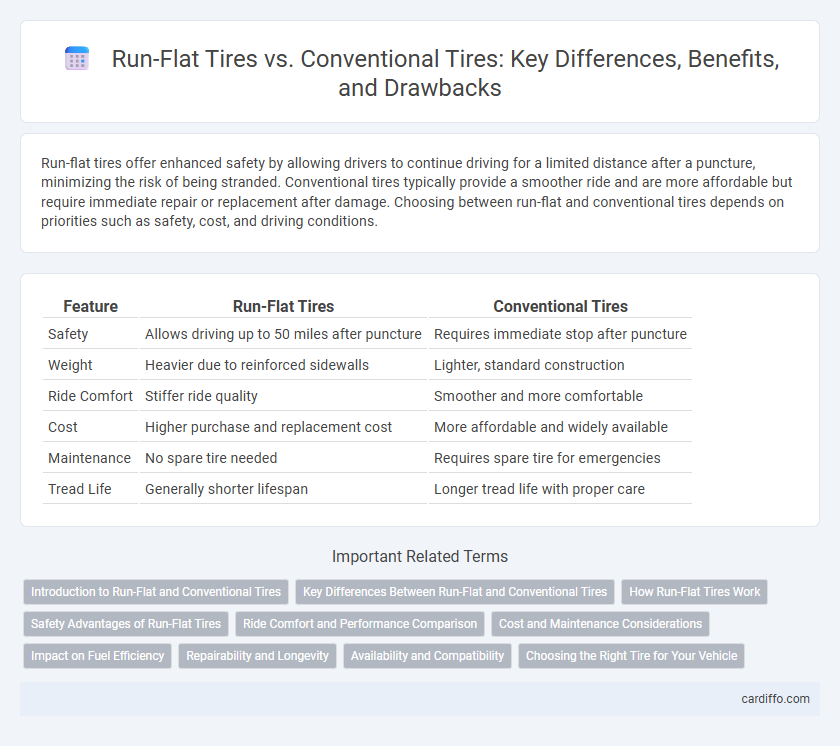Run-flat tires offer enhanced safety by allowing drivers to continue driving for a limited distance after a puncture, minimizing the risk of being stranded. Conventional tires typically provide a smoother ride and are more affordable but require immediate repair or replacement after damage. Choosing between run-flat and conventional tires depends on priorities such as safety, cost, and driving conditions.
Table of Comparison
| Feature | Run-Flat Tires | Conventional Tires |
|---|---|---|
| Safety | Allows driving up to 50 miles after puncture | Requires immediate stop after puncture |
| Weight | Heavier due to reinforced sidewalls | Lighter, standard construction |
| Ride Comfort | Stiffer ride quality | Smoother and more comfortable |
| Cost | Higher purchase and replacement cost | More affordable and widely available |
| Maintenance | No spare tire needed | Requires spare tire for emergencies |
| Tread Life | Generally shorter lifespan | Longer tread life with proper care |
Introduction to Run-Flat and Conventional Tires
Run-flat tires are designed with reinforced sidewalls that support the vehicle's weight even after a puncture, allowing limited driving without air pressure. Conventional tires rely on air pressure for structural integrity and require immediate repair or replacement if punctured. This innovation in run-flat technology enhances safety and convenience by reducing the risk of sudden tire failure and enabling drivers to reach service stations without changing tires on the roadside.
Key Differences Between Run-Flat and Conventional Tires
Run-flat tires are designed with reinforced sidewalls that support the vehicle's weight even after a complete loss of air pressure, allowing continued driving for up to 50 miles at reduced speeds. Conventional tires require immediate repair or replacement after a puncture, as they cannot maintain structural integrity without air pressure. Run-flats typically weigh more and have stiffer rides compared to conventional tires, which offer better fuel efficiency and a smoother driving experience.
How Run-Flat Tires Work
Run-flat tires feature reinforced sidewalls that support the vehicle's weight even after a puncture, allowing continued driving for up to 50 miles at reduced speeds. These tires maintain structural integrity by preventing air loss from causing tire collapse, enhancing safety and convenience. Unlike conventional tires that require immediate replacement or repair after a blowout, run-flat tires enable drivers to reach a service location without stopping.
Safety Advantages of Run-Flat Tires
Run-flat tires offer significant safety advantages by allowing drivers to maintain control and continue driving after a puncture, reducing the risk of accidents caused by sudden tire deflation. Their reinforced sidewalls prevent tire collapse, which enhances stability and vehicle handling during emergencies. Unlike conventional tires, run-flat technology eliminates the immediate need to stop in potentially dangerous roadside conditions, improving overall driver safety.
Ride Comfort and Performance Comparison
Run-flat tires typically offer enhanced safety by allowing continued driving after a puncture, but they often have stiffer sidewalls that may reduce ride comfort compared to conventional tires. Conventional tires generally provide a smoother and quieter ride due to their more flexible construction, which absorbs road irregularities better. Performance-wise, run-flat tires deliver reliable handling during emergencies, while conventional tires usually excel in overall traction and fuel efficiency under normal driving conditions.
Cost and Maintenance Considerations
Run-flat tires typically cost 20-50% more than conventional tires, with specialized rubber compounds and reinforced sidewalls driving the higher price. Maintenance expenses are generally lower for run-flats since they eliminate the need for immediate tire changes after a puncture, but repairs can be more costly and less frequently successful compared to conventional tires. Conventional tires offer more affordable replacement and repair options, though they require carrying a spare tire and more frequent maintenance to avoid roadside emergencies.
Impact on Fuel Efficiency
Run-flat tires typically have stiffer sidewalls and increased weight compared to conventional tires, which can lead to higher rolling resistance and reduced fuel efficiency. Conventional tires tend to be lighter and more flexible, promoting better fuel economy during regular driving conditions. Choosing run-flat tires may compromise fuel savings but offers enhanced safety benefits in the event of a puncture.
Repairability and Longevity
Run-flat tires offer enhanced repairability through their ability to maintain stability after punctures, allowing drivers to reach repair facilities without immediate tire replacement. Conventional tires generally require prompt repair or replacement upon puncture, impacting overall longevity if repairs are delayed. While run-flat tires often have reinforced sidewalls that may reduce tread lifespan compared to conventional tires, their damage-resistant design can extend operational usability in critical situations.
Availability and Compatibility
Run-flat tires are available on a growing number of vehicles but remain limited compared to the widespread availability of conventional tires across all markets. Compatibility varies as run-flat tires require specific wheel designs and tire pressure monitoring systems (TPMS), whereas conventional tires fit standard wheels without additional equipment. Conventional tires offer broader compatibility with most vehicles and tire shops, making them easier to replace or repair globally.
Choosing the Right Tire for Your Vehicle
Run-flat tires provide enhanced safety by allowing continued driving up to 50 miles after a puncture, reducing the risk of being stranded. Conventional tires offer a wider range of options and generally cost less but require immediate repair or replacement after a flat. Selecting the right tire depends on your driving habits, vehicle compatibility, and prioritization of safety versus cost efficiency.
Run-flat tires vs Conventional tires Infographic

 cardiffo.com
cardiffo.com